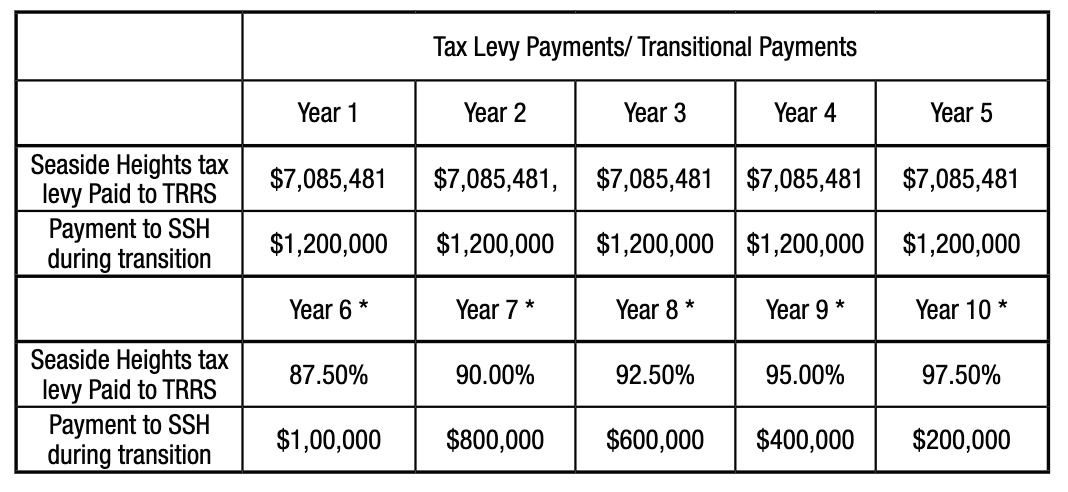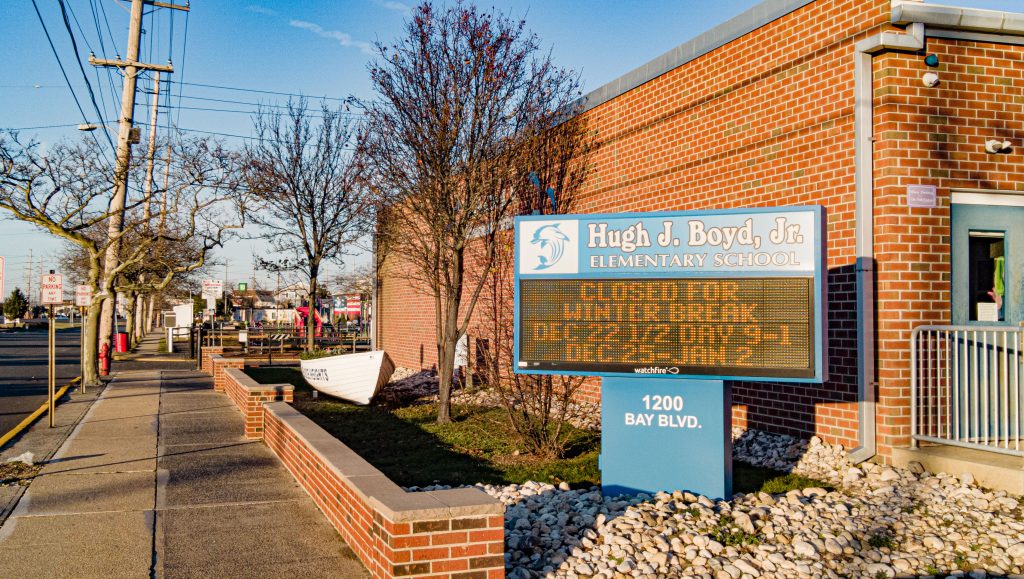Residents of the numerous municipalities which make up the Toms River Regional school district, plus the independent Seaside Heights district, will vote Tuesday on a referendum to consolidate the two.
Currently, Seaside Heights students are educated from preschool through sixth grade at the Hugh J. Boyd Elementary School on Bay Avenue. They then move on to Central Regional Middle School and Central Regional High School, located about 18 miles away in Berkeley Township. Merging the districts would bring older students closer to Seaside Heights at intermediate and high schools in Toms River, however after a maximum period of five years, the Boyd school would likely close, with students attending East Dover Elementary School or schools which offer special programs.
The debate over the consolidation of the districts began in the aftermath of Superstorm Sandy, when Seaside Heights sought state aid to bridge the gap between the ratable base lost in the storm and the budget required to provide essential services. The state strongly recommended – some would argue ordered – a pair of studies to be conducted to determine whether savings could be achieved by eliminating Seaside Heights as a regular operating district and having it subsumed by the regional district.
The outcome of the studies, which showed poor performance by students in Seaside Heights, touched off a debate as to whether students with special needs would be better served in the regional district, where many argue more services are available. Historically, Seaside Heights students have often come from transient families, many of whom do not speak English at home. Simultaneously, residents have debated whether joining the Toms River district would have short-term tax benefits, but long-term property assessment ramifications, for property owners.
The powerful New Jersey Education Association has opposed the consolidation plan despite the promise that no teaching staff would lose their jobs – they would retain employment within the Toms River district – however staff members have expressed emotional arguments about Seaside Heights’ unique school culture, a sense of community and small classes that they feel are more personalized than what children would experience in a large district.
Issue One: Education
Mary Robinson-Cohen, a former teacher and Roosevelt Public School District superintendent who is also an attorney, was one of the consultants who led the study that ultimately recommended consolidation.
“In all of the state testing, unfortunately, the children were lagging behind,” said Cohen. “There were no categories where the children were advanced-proficient and in the other categories they were minimally proficient. … The children were, mainly, below proficient.”
The first portion of the 104-page report focused on the PK-6 education provided by the Seaside Heights school district. Cohen took a major role in presenting the educational aspects of the report to the borough council in 2022, which shed light on challenges faced by the district. The district, the report found, failed New Jersey’s Quality Single Accountability Continuum, or QSAC, a monitoring program that evaluates school districts and recommends areas in need of improvement.
The Seaside Heights district has long been unique in Ocean County, whose student population is overwhelmingly white and sociologically middle class. Seaside Heights, in contrast, has a large immigrant population whose children increasingly do not speak English natively, with another significant portion of its non-immigrant students originating from transient families residing in short-term seasonal rentals on the barrier island. The town, as widely reported, is changing rapidly, with motels and aging rental properties being replaced en masse by high-end condominiums and single-family homes that are occupied by retirees and seasonal residents. That is leading to a decline in student population as fewer low-cost rental units are available after Labor Day each year, resulting in a smaller population of students who require services some argue can only be provided in a larger district with wider resources.
The study examined test results of exams administered both before and after the coronavirus pandemic.
Mayor Anthony Vaz, himself a retired schools superintendent in multiple districts, said the potential benefits to students attending a larger district cannot be ignored.
“I envision a community that is going to have fewer children in the future, because we see that decline. If someone is paying $800,000 or $1 million for a condo, they’re not going to rent it for $1,000 per month in the winter,” he said. “You can’t operate a school with a minimal amount of children, and you really can’t give a minimal amount of children a good education because you can’t support the services they may need.”
Issue Two: Property Taxes
Toms River school officials blanketly rejected the idea of a sending-receiving relationship with Seaside Heights, wherein students would be charged per-pupil tuition to attend TRRS, funded by local taxpayers. Instead, the regional district believes tax dollars generated by adding Seaside Heights’ ratable base to its jurisdiction will help obtain more state funding as the district faces state funding cuts.
The negative consequences of adding Seaside Heights to the TRRS district would be realized if the borough’s increasing value of real estate outpaces Toms River proper and its other member municipalities. Per-pupil costs, as experienced in neighboring towns such as Seaside Park, could skyrocket.
As part of its push for regionalization, the state has committed to subsidizing Seaside Heights’ transition to the new district and has guaranteed property tax savings for 10 years. Despite the subsidies, Toms River and the other districts that make up TRRS would still see savings themselves, though after the subsidies end in a decade, Seaside Heights residents would be subject to a formula that would determine how much money they would be obligated to send the regional district. This number is largely unknown.

In a more recent development, a compromise measure emerged from TRRS Superintendent Michael Citta that would keep the Boyd school open for a maximum of five years dependent on student population.
“Mike Citta has gone out of his way to work a process out that will meet the number and make it work,” said Vaz.
According to Vaz, the plan calls for the Boyd school to remain open for a maximum of five more years as long as 125 students are attending school there.
“The school would close after five years under the new plan,” said Vaz. “As long as there are 125 kids, it will stay open. If it goes below that number, the school would have to close the next year.”
A revised plan could also see the TRRS school board grow to an 11-member body, with Toms River gaining an additional representative alongside Seaside Heights.
If the referendum fails, the status quo – keeping the Boyd school open and sending students to Central Regional for grades 7-12 would continue. The Central Regional district does not have a say in the matter and is not part of the vote.
A list of polling places is available online via the Ocean County Clerk’s Office. Polls are open from Polls open 1:30 p.m to 8 p.m. Voters were required to register to vote by March 26 to participate in the referendum.

Advertisement

Seaside Heights & Seaside Park
Seaside Heights School Board Seeking More Participation, Will Change Meeting Times

Police, Fire & Courts
Seaside Park Man, 68, Charged in Fatal Crash With Pedestrian

Ortley Beach & North Beaches
Lottery Ticket Worth $10K Sold at Ortley Beach Acme

Ortley Beach & North Beaches
Abandoned Private Island ‘Mansion’ in Barnegat Bay Poised for Demolition








